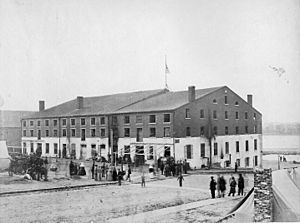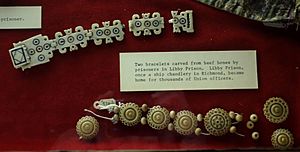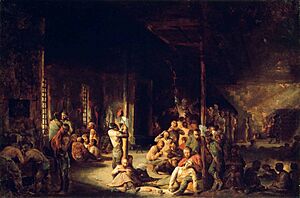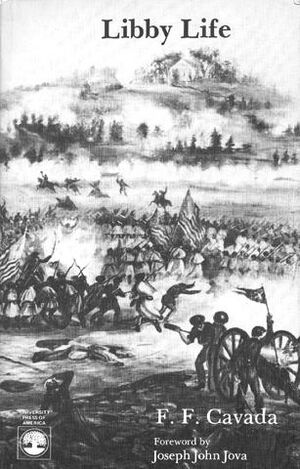Libby Prison facts for kids
Libby Prison was a famous Confederate prison in Richmond, Virginia. This was during the American Civil War. It became well-known for its very crowded and harsh conditions. Union Army officers were held there. Prisoners suffered from sickness, not enough food, and many died. By 1863, about one thousand prisoners were packed into large rooms. These rooms had open, barred windows. This meant prisoners were exposed to all kinds of weather and extreme temperatures.
The building was a food warehouse before the war. In 1889, a man named Charles F. Gunther moved the whole building to Chicago. He turned it into a war museum. About ten years later, the building was taken apart. Its pieces were sold as souvenirs.
Contents
History of Libby Prison
The prison was a three-story brick warehouse. It was located on Tobacco Row by the James River. Before it became a prison, a company run by Capt. Luther Libby and his son used it. They sold ship supplies and groceries.
The Confederate government started using the building as a hospital and prison in 1861. By 1862, they used it only for Union officers. This was because so many prisoners were being captured. The prison had eight large rooms. Each room was about 103 feet long and 42 feet wide. Prisoners were kept on the second and third floors. Windows had bars but were open to the outside. This made conditions very uncomfortable. Poor sanitation and too many people caused diseases to spread. In 1862, there were 700 prisoners. By 1863, the prison held more than its maximum of 1,000. Many prisoners died in 1863 and 1864. This was made worse by a lack of food and supplies. Because so many people died, Libby Prison is often seen as the second worst prison. Only Andersonville Prison in Georgia was considered worse.
In 1863, the New York Times newspaper printed a description of Libby Prison. It was from a diary entry supposedly written by a prisoner. The next year, Captain I.N. Johnston, who escaped from Libby Prison, confirmed the article. He said the building was brick, about 140 feet wide and 100 feet deep. It had nine rooms with low ceilings and poor air flow. Windows were barred, but you could see the James River. He said the area around the prison was not pleasant. Sentinels (guards) constantly walking nearby reminded prisoners they were not there by choice.
In March 1864, there were worries about the safety of the capital city. There were also concerns about prison security and a lack of supplies. The next month, Union officer Harland Richardson asked for supplies to be sent to Libby. These requests were often delayed or ignored. The U.S. War Department sent supplies to active Union soldiers instead. Confederates allowed one shipment of supplies as their own ran low. During the late spring and summer, most prisoners were moved from Richmond. Enlisted men went to Andersonville. Officers from Libby were sent to a new prison in Macon, Georgia. From April to August 1864, Libby was still used. It mostly held Union officers temporarily. It also held a small number of Confederate military criminals.
On August 10, 1864, the Richmond Sentinel newspaper described some "wounded Yankee negro soldiers." They were described as looking very bad. The newspaper noted that about 500 local Black people watched them. The prisoners looked scared and smelled bad. On September 18, The New York Times reported that about 230 Union officers were still in Libby Prison. Due to the Siege of Petersburg and more prisoner transfers, the number of inmates grew. Two weeks before the New York Times report, the Richmond Dispatch said 300 more Union captives had arrived at Libby.
In autumn 1864, newspapers reported more prisoners at Libby. On October 10, 1864, the Richmond Sentinel reported 1,552 "Yankee prisoners" arrived. 1,114 of them were sent to Salisbury, North Carolina. This was to make room for more prisoners. Four days later, Confederate officers discussed what to do with 82 "Colored Troops" who arrived. A general ordered "all negroes on hand not employed about the prison" to work on fortifications. The commandant thought the troops were happy to work instead of being in prison. They joined 68 other Black soldiers who were sent to work earlier. Some of these Black soldiers were free, others were slaves. The remaining 66 "U.S. Colored Troops" had either died or were too sick to leave.
Newspapers continued to report on the growing number of prisoners. On October 24, the Richmond Whig reported 1,400 enlisted men and 37 officers arrived. On October 29, the Richmond Whig reported 700 Union soldiers were sent to Libby. Two days later, more newspapers reported 400 more Union prisoners. On November 2, 1864, the Richmond Whig reported 400-500 more Yankee prisoners arrived. Union officers wrote letters asking for help. These letters showed great suffering and worsening conditions in Libby. Newspapers on both sides of the war criticized how prisoners were treated.
After Richmond was captured in 1865, Union authorities used Libby Prison. They held former Confederate officers there. Conditions were reportedly better for these prisoners than for Union officers or other prisoners during the war.
In April 1865, U.S. President Abraham Lincoln visited Richmond. He walked around the city. When he saw Libby Prison, a crowd said, "We will tear it down!" Lincoln replied, "No, leave it as a monument."
In 1880, the Southern Fertilizer Company bought the building. Nine years later, Charles F. Gunther, a candymaker, bought it. He took it apart and moved it to Chicago, Illinois. There, it was rebuilt and became a war museum from 1889 to 1899. When the museum did not attract enough visitors, the building was taken apart again. Its pieces were sold as souvenirs.
Prisoner Conditions
In 1863, a group of Union surgeons were released from Libby. They wrote about their experiences treating prisoners in the hospital there:
They said that more than ten percent of all prisoners were sick. These sick men needed careful attention. But they only received corn bread and sweet potatoes. Meat was no longer given to any prisoners. All sick or well officers and privates received very poor corn bread instead of wheat bread. This was not good food for hospital patients with diarrhea, dysentery, and fever. They also saw many shocking cases of suffering and death from long sickness and not enough food.
The surgeons said prisoners always asked for more food. Many were only half-clothed. New prisoners who were already sick often died quickly, sometimes in one night. The surgeons believed that thousands of men would be "permanently broken down" if they survived. This was due to "abuse, neglect, and semi-starvation." They told a story about 200 wounded prisoners. These prisoners came from the Battle of Chickamauga. They had only been given a few hard crackers during their three-day journey. Then they suffered two more days in prison without medical care or food.
An article in the Daily Richmond Enquirer in 1864 described prison conditions vividly:
Libby takes in captured Federals by the scores, but lets none out. They are crowded into every space. At the bathing troughs, around the cooking stoves, everywhere there is a pushing crowd. At night, every inch of the floor is covered by uneasy sleepers. They lie side by side, packed as tightly as sardines in a can.
Lieut. Colonel Federico Fernández Cavada was part of the Union Army's Hot Air Balloon Unit. He was captured during the Battle of Gettysburg and sent to Libby. He was released in 1864. Later that year, he published a book called LIBBY LIFE: Experiences of A Prisoner of War in Richmond, VA, 1863-64. In his book, he described the cruel treatment in the Confederate prison.
In the introduction, Cavada wrote:
It was a beautiful country we had just passed through. But it held no charm for tired eyes forced to see it through enemy bayonets. We felt little joy for beauty. On our worn faces, only this was written: "Give us rest, and food."
Cavada published his story before 1865. Other former Union prisoners also wrote memoirs after the war ended in April 1865.
The Libby Chronicle
The Libby Chronicle was a newsletter written by the prisoners in Libby during the summer of 1863. The editor read it aloud every Friday morning. Even though conditions were harsh, the newsletter showed a funny side.
Issue number two had a poem called "Castle Thunder." It had a "dryly witty" view of prison life:
We have eighteen kinds of food, though 'twill stagger your belief,
Because we have bread, beef and soup, then bread, soup and beef;
Then we sep'rate around with'bout twenty in a group,
And thus we get beef, soup and bread, and beef, bread and soup;
For dessert we obtain, though it costs us nary red,
Soup, bread and beef, (count it well) and beef and soup and bread.
Such poems helped keep the prisoners' spirits up. The next week's issue started with a section called "Encore." It said that the poem "Castle Thunder" was so popular it was printed again. The laughter it caused "has done more good in Libby than cartloads of Confederate medicine."
Many prisoners felt angry at President Abraham Lincoln. They thought he was responsible for them being held so long. The editors of The Chronicle disagreed. They said these officers acted "more like spoiled children" than brave soldiers.
Some men tried to get released on their own. For example, a young surgeon wrote a letter to a newspaper editor. He promised that if he was released, he would find the editor's "Rebel son" and take care of him. The Chronicle editors reported that this officer also offered to leave the Federal army if the Confederates would help him. But the Confederates did not want him.
Escape from Libby Prison
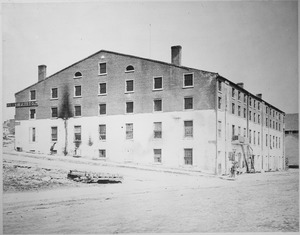
In the second week of February 1864, 109 Union officers took part in a famous escape. The newspapers later called it the Libby Prison escape. Captain Morton Tower wrote in his memoirs about his successful escape. He said that on the night of February 9th, the escape began when it was dark enough. Major Hamilton, Col. Thomas E. Rose, and others went first. Captain Tower and Col. Davis went through the tunnel just as the clocks in Richmond struck midnight. Near daybreak, they reached a thicket of woods to rest. Captain Tower and Col. Davis avoided being caught again. They joined 57 other escapees who also made it to Union lines.
The Charleston Mercury newspaper reported the story:
At the base of the east wall, a tunnel was found. Its entrance was hidden by a large rock. This stone, when moved, showed a path that led outside. A small Black boy was sent into the tunnel to explore. By the time Major Turner and Lieutenant LaTouche got outside the building, the boy shouted. He had reached the end of the underground path. The tunnel went directly under three guards. They walked across a paved alleyway, more than fifty feet. It came out inside the area behind Carr warehouse.
The distance was measured so well that it came out exactly inside the area. This suggests outside help. Once the connection was open, prisoners could crawl through the tunnel one by one. They came out at least sixty feet from any guard post. Then they could leave, one by one, through an arched gateway to a meeting spot. To reach the tunnel entrance, prisoners had to cut through the hospital room and a closed stairway. All the work must have been done at night. All signs of the work were hidden before morning. The tunnel itself took several months to build. It was about three feet wide and at least sixty feet long. It curved around rocks.
Three tunnels were started. The first one ran into water and was left. The second hit the building's wooden foundation. The third one reached a small carriage shed about 50 feet away. Escapes happened often at both Union and Confederate prisons.
Letters from Libby
The Christian Recorder and other newspapers sometimes printed letters from prisoners. This was before Richmond fell in April 1865. The rules at Libby Prison limited men to six lines for their letters to family and friends. Here is an example:
"My Dear Wife. - Yours received - no hopes of exchange - send corn starch - want socks - no money - rheumatism in left shoulder - pickles very good - send sausages - God bless you - kiss the baby - Hail Columbia! - Your devoted husband."
After the War
In 1907, nails from Libby Prison were melted down. They were used to make the Pokahuntas Bell for the Jamestown Exposition. The front door of Libby Prison is now on display. You can see it at the American Civil War Museum. This museum is located at the former Tredegar Iron Works in Richmond.


